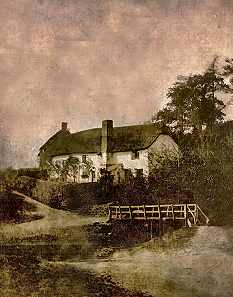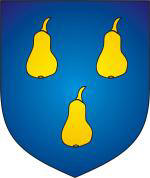

|
From Draheford in AD1086, when there were seven families listed in the Doomsday book as having cattle and sheep, to Drayford at the turn of the century when there were twelve houses including Drayford Mill, little has changed in this small hamlet situated on the banks of the Little Dart River and Adworthy Brook. There were Stone Age people on the ridge by West Yeo six thousand years ago, but all they left were traces of the flints that they used. The first known mention of Drayford comes in 1086 AD in the Domesday Book where it is referred to as the manor of "Draheforda", the name is said to be made up of two Old English words, ford and dray, dray possibly meaning drag or carry, but the experts do not agree. The manor was in the holding of Walter Claville who's name did not appear in the rolls of the Battle of Hastings. Following the battle, he seems to have acquired holdings as an under-tenant in Suffolk under Robert Malet, and holdings in Devon. His home domain in Normandy was at Claville de Caux in the Seine-Inf near Rouen.
Appledore Ayshford Boehill Leigh (Churchstow) Leonard Shobrooke (Morchard Bishop) In 1086, there were seven families in Drayford; they had cattle and sheep, and there were meadows, pasture and woods. The Witheridge Parish Registers have several references to the Trix family, and also to William and Elizabeth Godswell, who may have given their name to Godswells; or else their ancestors may have taken their name for "God's Well". In 1836, the Manor belonged to the Fellowes family, Earls of Portsmouth. At that date, Drayford Mill had 7 acres, Trixes Tenement 13 acres, Stuckeys 46 acres, and Godswells 75 acres.
By 1555 the manor was owned by the Stuckley family of Affeton, and remained in their possession until Scipio Stuckley sold it to Sir Edward Chichester of Eggesford in 1632. At the time of the sale the schedule of properties consisted of four tenements, two cottages, a house, and the mill. The miller at this time being one Hugh Moore, and the mill was described as being a Tuck Mill which indicated that at that time it was being used in the production of cloth, and not for grinding corn. It was in the same year that the first mention of a tenement occupied by Phillip Trix, whose name persisted through the ages in the names of Trixies Wood and Trixies Cottages. By 1836 the manor was owned by the Fellowes family, Earls of Portsmouth, and Drayford Mill was shown as having 7 acres, Trixies Tenement 13 acres, Stuckeys 46 acres, and Godswells 75 acres. In 1759 when the road from South Molton became a turnpike and named The Great Road to Exeter, the route passed through Drayford with the local Toll House being situated at Thornham Chapel Cross. The existing packhorse bridge, built prior to 1765 when it appeared on Donne's Map of Devon was not wide enough, and as a consequence most of the wheeled traffic had to use the ford until a new bridge was built in 1914. The Tithe Map of 1840 shows a few differences from the OS map of 1889. In 1840 the mill house was on the river side of the barn and attached to it, forming an L shape. Hillside, Godswells, and Stukleys and were much the same, but there were several farm buildings across the road from Hillside. Across the Worlington road by Rock was a cottage. In the Schedule that goes with the Tithe Map the Hon Newton Fellowes (Lord of the Manor of Drayford, and later Earl of Portsmouth) was shown as owning Godswell (75 acres, occupied by Robert Middleton), "Stuckleys" (47 acres, occupied by John Vicary), and four dwellings under the common heading of Rock. The main house had with it eleven fields and an orchard, totalling 54 acres. In 1850, the Directory of Devon shows Drayford as having a blacksmith, a butcher, 3 carpenters, a tailor, and a boot and shoemaker, but eighty years before that Drayford was home to other fine Craftsmen. William Bradford made long case clocks from 1760 to 1808, when he and his son (William), moved to Tiverton. Their signboard remained on the wall of one of Trixes Cottages until the 1960s. The Census of 1861 gives a picture of the population of Drayford then. It totalled 83 people, of whom 23 occupied the cottages called Rock. In one of them, a 33-year-old widow, Charlotte Middleton, kept a shop. In another was a stonemason, William Milton, and seven members of his family, including his older sons Thomas, 16 (stonemason) and Samuel, 13,(masons labourer). In a third cottage was a family of six Kivells and a widow Conibear, who was a dressmaker. In the fourth cottage lived the eight members of the Reed family (including two farm workers and a dressmaker). The remaining population of Drayford was sixty, and they had among them a Thatcher (William Knight), a blacksmith (John Greenslade), a seam-stress (Jane Moss), a carpenter (William Moss), a butcher (William Clapp) and several farm workers. By 1871 family names in Drayford included Tucker, Greenslade, Down, Moss, Reed, Chudley, Avis, Edworthy, Knight, Drew, Davey, and Kivell. The Phillips family were at the Mill, and Thomas Venner shared Godswells with the Webber and Bennett families. In 1891, there were still Phillips's at the Mill, with Thomas Stoneman. The Venners were on their own at Godswell; Thomas was a Thatcher, as was his son William, and his son Thomas (aged 15) was a Thatcher's assistant. Chudleys, Lewises, Ways, Gards, Slomans, and Tanners, were other families mentioned. The Stuckeys name however, was not. In 1891 miller, thatcher and farm worker were the only trades quoted. Agriculture had always been a major source of employment in Drayford, although cloth making and milling have also played their part, but of significance was the development in the 1920's of Coombe Quarry by Archibald Nott. Down the road to Drayford, beyond Coombe Ball, and short of the Mill there lies on the left Coombe Quarry. For many years, this had provided stone for local buildings, on an ad hoc basis, including that for Drayford Bridge in 1914. However, in the early 1920s, Archibald Nott brought it, and the business expanded creating a number of permanent jobs. Crushed stone was then much in demand for road maintenance and improvement. Laden Lorries could not use Drayford Bridge, and so the only routes out were Coombe Ball and Have's Hill. Notts heavy steam Lorries soon cut these roads so badly that the County Council threatened to end Notts contracts unless they repaired them. Archie Nott was not a man to be threatened, and he refused. However, he came up with a clever alternative. He built an aerial ropeway from the quarry to the main Witheridge to South Molton road, where he set up a new crushing plant. This worked well. It also gave rise to a local legend, namely that one day the unpopular quarry manager decided, against company rules, to take a ride in one of the buckets. When he was halfway along, or so rumour has it, an unknown pair of hands put the machinery out of gear and left him suspended above the Little Dart River. By the end of the 1930s, Scotts of Bampton had purchased the Ropeway and the "depot" as it was known had ceased work. The 1939-45 war brought a new lease of life to the quarry. Construction of Winkleigh Aerodrome in 1943 led to the demand for hundreds of lorry loads of stone, and this came from Coombe Quarry. So heavy was the traffic that a one-way system applied, laden trucks going up Coombe Ball, and returning empty down Have's Hill, The quarry closed some years later, and in spite of one or two attempts to reopen it, has remained closed. Previous Last Edited 03/07/2006 Copyright © 2000-2006 Witheridge Unless otherwise indicated on the page in question, the photographic images reproduced on this site belong to the Witheridge Archives, and, as such may not be reproduced for commercial purposes without written permission. However, you are welcome to use any of the photographs belonging to the archive for personal and/or non-commercial use. Any material shown as not being owned by the archive may not be reproduced in any form without first receiving written permission from the owner of the material in question. |



